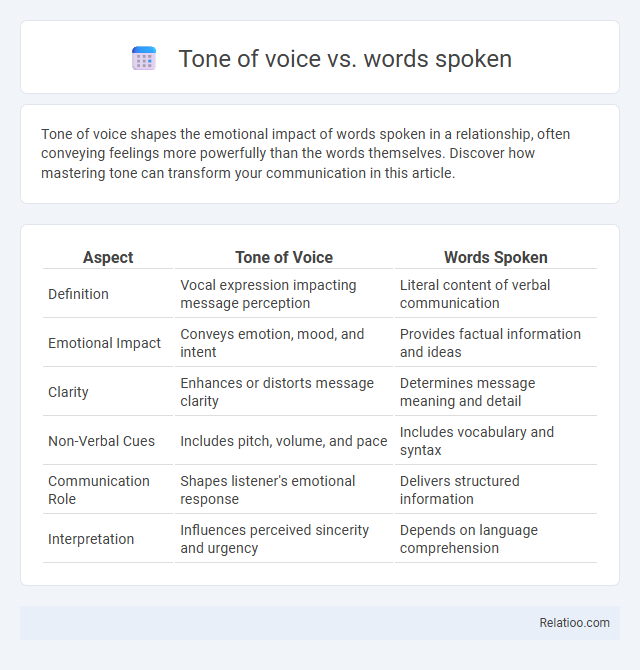Tone of voice shapes the emotional impact of words spoken in a relationship, often conveying feelings more powerfully than the words themselves. Discover how mastering tone can transform your communication in this article.
Table of Comparison
| Aspect | Tone of Voice | Words Spoken |
|---|---|---|
| Definition | Vocal expression impacting message perception | Literal content of verbal communication |
| Emotional Impact | Conveys emotion, mood, and intent | Provides factual information and ideas |
| Clarity | Enhances or distorts message clarity | Determines message meaning and detail |
| Non-Verbal Cues | Includes pitch, volume, and pace | Includes vocabulary and syntax |
| Communication Role | Shapes listener's emotional response | Delivers structured information |
| Interpretation | Influences perceived sincerity and urgency | Depends on language comprehension |
Understanding Tone of Voice vs. Words Spoken
Understanding tone of voice is essential because it conveys emotions and intentions that words alone may not express, influencing how messages are interpreted. While words provide the literal meaning, tone reveals underlying attitudes, such as sarcasm, sincerity, or anger, adding depth to communication. Misinterpretation often occurs when tone is ignored, highlighting the critical role it plays compared to simply focusing on the spoken words.
The Science Behind Tone and Verbal Communication
The science behind tone of voice reveals it conveys emotions and intentions beyond the literal meanings of words spoken, influencing how Your message is perceived and understood. Nonverbal cues, including pitch, volume, and pace, interact with verbal communication to create a comprehensive emotional context, often overriding the actual words. Research shows that up to 93% of emotional meaning in face-to-face communication is derived from tone and nonverbal signals rather than verbal content alone.
How Tone Influences Message Interpretation
Tone of voice significantly influences message interpretation by conveying emotions and intent beyond the literal words spoken, shaping how the receiver perceives the speaker's attitude. Nonverbal cues, such as facial expressions and body language, complement tone to create a fuller understanding of the message's meaning. Misalignment between tone, words, and nonverbal signals can lead to misunderstandings and affect communication effectiveness.
The Role of Words in Conveying Intent
Words carry the core meaning and intent in communication, shaping how your message is understood. While tone of voice adds emotional context and nonverbal cues like gestures reinforce sincerity, the precise choice of words directly conveys your purpose and ensures clarity. Selecting specific vocabulary tailored to your audience strengthens the impact and reduces misunderstandings, making your verbal message more effective.
Tone of Voice: Subtle Signals and Hidden Meanings
Tone of voice conveys subtle signals and hidden meanings that often outweigh the actual words spoken, revealing emotions such as sarcasm, sincerity, or urgency. You can interpret feelings and intentions through variations in pitch, volume, and pace, which guide the context beyond verbal content. Nonverbal cues complement these vocal signals, but tone alone frequently provides the most nuanced insight into underlying messages during communication.
When Words Clash with Tone: Mixed Messages
When words contradict tone of voice, the recipient often relies more heavily on nonverbal cues such as facial expressions and body language to interpret the true message. Mixed messages create confusion and undermine communication effectiveness, as tone conveys emotions and intent that words alone may fail to express or may even contradict. Understanding the interplay between verbal content, vocal intonation, and nonverbal signals is essential for accurate message decoding and reducing misunderstandings.
The Impact of Tone Versus Words in Relationships
Tone of voice often carries more emotional weight than the actual words spoken, significantly influencing relationship dynamics by conveying sincerity, anger, or affection beyond the literal meaning. Nonverbal cues like facial expressions and body language further amplify or contradict the spoken message, creating a complex interplay that shapes trust and intimacy. Research shows that misunderstanding tone can lead to conflicts even when the words themselves are neutral or positive.
Tone and Words in Professional Communication
Tone of voice significantly influences the interpretation of your words spoken in professional communication, often conveying emotions and intentions beyond the literal meaning. Clear, respectful word choice paired with an appropriate vocal tone fosters trust and understanding, enhancing interpersonal relationships. Your ability to align tone and words effectively ensures messages are received as intended, minimizing misunderstandings in the workplace.
Cultural Differences in Tone and Verbal Expression
Cultural differences significantly shape tone of voice, words spoken, and nonverbal cues, influencing communication effectiveness and interpretation. In high-context cultures like Japan, subtle tone variations and nonverbal signals, such as silence or gestures, carry more weight than explicit verbal expressions. Conversely, low-context cultures like the United States prioritize clear, direct verbal communication, while tone and body language serve to reinforce the spoken message.
Mastering Effective Communication: Balancing Tone and Words
Mastering effective communication requires balancing your tone of voice, words spoken, and nonverbal cues to convey your message clearly and authentically. Tone of voice influences how your words are perceived, while nonverbal signals such as gestures and facial expressions reinforce or contradict your verbal message. Understanding this interplay helps you connect better, avoid misunderstandings, and engage your audience more effectively.

Infographic: Tone of voice vs Words spoken
 relatioo.com
relatioo.com